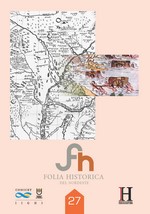Los guaraní y su orientación en el espacio
DOI:
https://doi.org/10.30972/fhn.0271226Palabras clave:
Guaraní, kaiowá, historia, cosmovisiónResumen
El presente trabajo pretende abordar la experiencia de los guaraní-kaiowá referente a su orientación en la selva y señalar, brevemente, algunas similitudes con los datos recopilados por los misioneros que entraron en contacto con los guaraní durante la colonia, especialmente, los de la Compañía de Jesús, quienes registraron importantes informaciones sobre la cultura guaraní, incluidas la fauna y la flora del Río de la Plata, entre otras regiones. La convivencia con la naturaleza les ha facilitado a los nativos orientarse, convenientemente, en el medio que le rodea, el bosque. Según los relatos de los kaiowá, durante siglos han logrado desenvolverse en perfecta armonía con la naturaleza y podrían desplazarse libremente, sea para cazar animales o recolectar frutas silvestres, de esta manera, atravesaban vastos territorios sin barrera alguna, muy diferente a la situación actual de muchos nativos tanto del Mato Grosso do Sul como los de Paraguay. La dinámica del viento, yvytu les permitía orientarse en medio de la selva; yvytu oipejuveha koty, el viento dominante, el otro medio infalible de orientación es el sol, kuarahy pyti’a, kuarahy sẽmba, oriente; kuarahy reike, poniente. Para circular por el monte dejaban trazos, cortando ramas de las plantas de modo que sirvan de señalización para volver a la casa. Habilidades que la sociedad, considerada moderna, no lo comprende o simplemente, desconoce. La orientación y habilidad, incomparables, que poseen los nativos nos invita a considerar la riqueza natural que ellos custodian y que están en permanente lucha para frenar la deforestación. Los habitantes más antiguos de estas zonas priorizaban el uso equilibrado de los recursos naturales. Por ejemplo, para sembrar y cosechar poseían un calendario lunar. Lógicamente, la división del tiempo, ára se basa en las fases de la luna, jasy ra’y, luna nueva; jasy renyhẽ, luna llena.Descargas
Publicado
Número
Sección
Licencia
Se deberá adjuntar una carta, en la que se declare que "el artículo titulado XXX”, es un trabajo original, que no ha sido ni total ni parcialmente publicado en ningún medio impreso o electrónico, que no ha sido remitido simultáneamente a otra publicación y que no se encuentra actualmente en proceso de evaluación en otra publicación. En el caso que sea aceptado para su publicación, transferimos los derechos de publicación a la revista Folia Histórica del Nordeste, quien asume los derechos para editar, publicar, reproducir, distribuir copias, electrónicas o multimedia e incluir el artículo en índices nacionales e internacionales o bases de datos. Por otra parte, dejamos constancia que las afirmaciones vertidas en el mismo son de exclusiva responsabilidad de las/los autoras/es". La carta deberá estar firmada por al menos uno de los autores.






